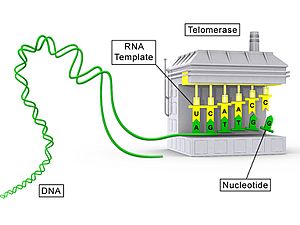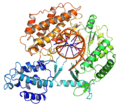Telomerase facts for kids

Telomerase is an RNA protein which is an enzyme. It adds DNA sequence repeats ("TTAGGG" in all vertebrates) to the end of DNA strands in the telomere regions.
The telomeres are disposable buffers blocking the ends of eukaryotic chromosomes. They are a region of repeated nucleotides containing noncoding DNA. Telomeres are destroyed during cell division, and are remade by the enzyme telomerase.
The function of telomeres is to avoid the loss of important DNA from chromosome ends. Every time the chromosome is copied 100–200 meaningless nucleotides are lost, which causes no damage to the organism's DNA. So, the telomeres are shortened after each replication cycle, and then are restored to their proper length by telomerase. Telomerases carry their own RNA molecule, which is used as a template to elongate the telomeres.
The existence of a compensatory mechanism (a 'fix') for telomere shortening was first predicted by Soviet biologist Alexey Olovnikov in 1973. He also suggested the telomere hypothesis of ageing and the telomere's connections to cancer.
Telomerase was discovered by Carol Greider and Elizabeth Blackburn in 1984 in the ciliate Tetrahymena. Together with Jack Szostak, Greider and Blackburn were awarded the 2009 Nobel Prize in Physiology or Medicine for their discovery.
Images for kids
-
Tribolium castaneum telomerase catalytic subunit, TERT, bound to putative RNA template and telomeric DNA (PDB 3KYL)
See also
 In Spanish: Telomerasa para niños
In Spanish: Telomerasa para niños



